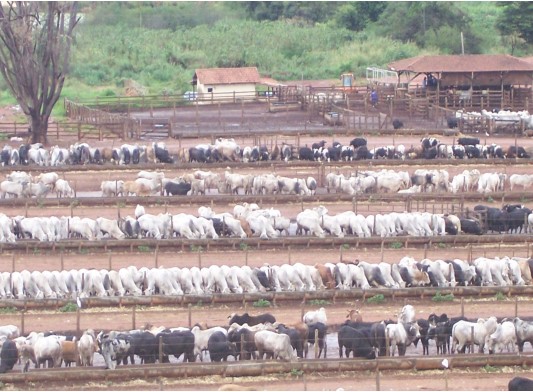Much is said about the devaluation of the arroba and, therefore, the low profitability of Brazilian beef cattle farming. A major villain in this story is the growing increase in production costs. However, few producers see that this increase in cost is not temporary and, unlike the vast majority who wait for a rise in prices, they mobilize to look for alternatives, so as not only to get out of the crisis, but also to strategically ensure the arrival of new episodes of economic imbalance in beef cattle farming.
Today, the intensification of production is the technological solution most used by professional livestock farmers. In this circumstance, the finishing confinement is almost always “called” to ensure greater pasture capacity throughout the year.
A residue of confinement is the production of manure, which should actually be seen as a by-product of this activity, as it presents itself as a source of fertilizer for use on the property itself, in grain or roughage production areas.
However, it is rare to find a confinement unit that uses manure efficiently. The misuse of this is due to the lack of adequate equipment, both for collection and distribution, and also due to the lack of suitability of the terrain of the confinement paddock for collection, loss of nutrients due to the delay in removing the manure, poor distribution, among others. But, mainly, due to the lack of knowledge of its qualities as a fertilizer, by confinement managers, which generates little interest in its use.
The advantages of cattle manure as fertilizers are (Kiehl, 1985; Malavolta, 1989; Moreira & Siqueira, 2002; Pauletti & Motta, 2004 and Rosa, 2005):
– improvement of soil structure (both for sandy and clayey soils);
– reduction of soil compaction processes;
– improved aeration and soil drainage;
– increased water storage capacity in the soil;
– reduction of the effects of erosion;
– source of macros and micronutrients;
– elevation of the soil CTC;
– improvement of the root growth condition;
– contribution to increasing pH in acidic soils;
– increase in the number of useful microorganisms in the soil, essential in combating pests;
– brings benefits for longer, as it slowly provides nutrients, prolonging the effects of fertilization;
– prevents mineral losses through leaching.
Many of these qualities cannot be seen by the naked eye by the producer. However, if we valued it only as fertilizer this would be clearer. According to a review by Pauletti & Motta (2004), an adult bovine excretes an average of 23.5 kg of feces and 9.1 kg of urine per day. Still according to the review by the same authors, the nutrient value of fresh cattle manure would be: 1.5 % of nitrogen, 1.4 % of P2O5, 1.5 K %2O and 15 % of dry matter. For micronutrients: 7.6 mg.kg-1 zinc, 21 mg.kg-1 copper, 105 mg.kg-1 of iron and 2.3 mg.kg -1 of manganese.
However, the composition of manure varies greatly, and this occurs depending on its state of decomposition, handling, storage, species and age of the animal and the handling and feeding these animals receive. Animals fed rations with high levels of concentrates produce manure richer in nutrients than animals raised on pasture. Adult animals eliminate around 80% of the nutrients they ingest, while young animals eliminate 50% of this total, therefore producing manure that is poorer in nutrients (Kiehl, 1985).
Let's see in the tables below (01, 02 and 03) the value of confinement manure, through comparison with the cost of nutrients present in chemical fertilizers:
Table 01. Chemical analysis of a sample of cattle manure:
Table 02. Valuation of nutrients present in the manure of the sample mentioned in table 01:
Table 03. Value of manure collected by the number of heads confined:

Table 03 shows the amounts that can be saved with chemical fertilizers through the use of fertilization with manure from the confinement. According to Malavolta (1989), although fertilization with cattle manure provides large increases in production, it cannot be used as the only source of fertilizer, as it is not properly balanced in terms of nutrient content. Therefore, fertilization with mineral fertilizers still needs to be balanced.
We should point out that the value in reais of the evaluated manure may be higher if recovery is also used for micronutrients.
In conclusion, the use of confinement manure as a fertilizer alone is justified, as it can considerably reduce the production costs of an intensive livestock farm.
Literature cited
Kiehl, EJ Organic Fertilizers. Editora Agronomica Ceres, 1985.
Malavolta, E. ABC of Fertilization. Ceres Publisher – 5th. Edition, 1989.
Moreira, FMS & Siqueira, JO Soil Microbiology and Biochemistry. UFLA Publisher, 2002.
Pauletti, V. & Motta, ACV Alternative Sources of Nutrients for Pasture Fertilization. XXI Symposium on Pasture Management. “Luiz de Queiroz” Foundation for Agrarian Studies, 2004.
Rose, B.; Freitas, K. R; Pinheiro, EP Use of Organic Waste of Animal Origin in Fodder Production. VII Goiano Symposium on Management and Nutrition of Beef and Dairy Cattle. Brazilian College of Animal Nutrition, 2005.
SOURCE: https://www.beefpoint.com.br/



